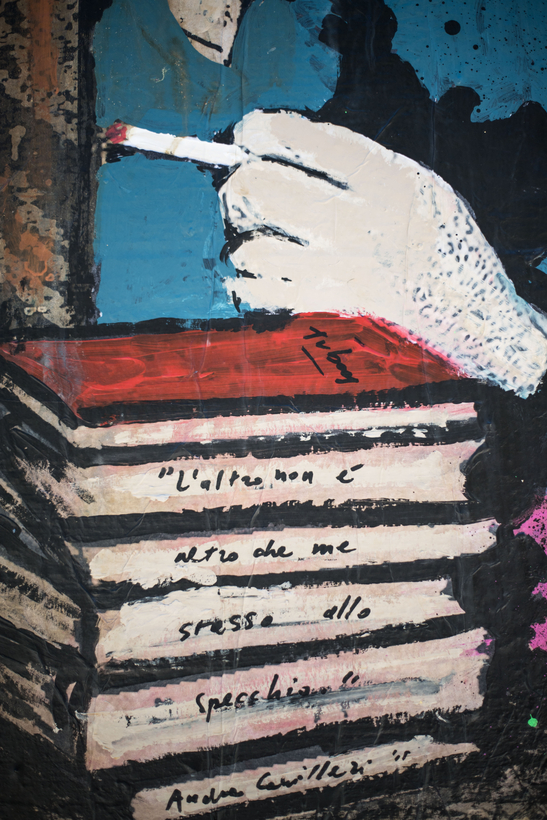A French archaeologist and historian, Fred Vargas (real name, Frédérique Audoin-Rouzeau) bends the police procedural to accommodate her own style and obsessions, which here include zoology, philosophy, classic French literature, and medieval history. Her Paris-based detective, Jean-Baptiste Adamsberg, grew up in the Pyrenees and has retained a certain mystical intuitiveness from his barefoot childhood in the mountains. Newly returned from a vacation in Iceland, he seems untethered as the book begins: “More vague and elusive than ever, with his wandering gaze and absent-minded smile, the commissaire seemed to have lost touch with the precisely carpentered joists which had always, in spite of everything, underpinned his approach.”
But as Adamsberg himself points out, “I can see perfectly well in a fog,” and proves his sharpness by neatly solving two crimes as a sort of a prelude to the main event, a situation in Nîmes involving the deaths of three old men who appear to have been bitten by brown recluse spiders. He thinks they may have been murdered, which his team finds ridiculous, but he persists, and soon finds himself entangled in an intricate web (I couldn’t resist) involving unspeakable acts of cruelty at an orphanage and a bona fide human recluse straight out of the Middle Ages.
In Vargas’s universe, the words of Balzac and Voltaire are more lethal than bullets, and knowledge of the properties of spider venom more useful than ballistics. This may sound like Gallic whimsy, but Vargas’s moral toughness, combined with her deadpan wit and gift for distinctive characters, make this novel as substantial and rewarding as a bowl of garbure, the Gascon peasant soup that sustains Adamsberg through this confounding investigation.
When Louise Penny’s series featuring Chief Inspector Armand Gamache began, in 2005, the group of eccentrics who inhabit the tiny Quebec town of Three Pines proved to be at least half the draw. Readers could imagine themselves hanging out with the arty crew in the bistro—the town’s social center—drinking strong coffee and nibbling on croissants while all hell occasionally broke loose around them. They served as an offbeat counterpoint to the principled, paternal Inspector Gamache of the Sûreté du Québec, who encountered a disproportionately large number of crimes in Three Pines.
Readers could imagine themselves hanging out with the arty crew, drinking coffee and nibbling on croissants while all hell occasionally broke loose around them.
There are only so many murders a small Canadian town can generate, so as the series progressed, Penny eventually upped her game, moving from sophisticated cozy to higher levels of mayhem and meaning. The resulting books were ambitious and portentous, leavened with a touch of spirituality, and A Better Man continues in that vein. Gamache has been busted down from Chief Superintendent of the entire Sûreté to head of homicide, a position he held early in his career, for his controversial handling of a case. Demoted, reviled on Twitter, despised by his scheming boss, Gamache is having a rough time, but he forges on, investigating the disappearance of a young pregnant woman with a brutal husband. The emotional ante increases for Gamache as potentially devastating floods threaten the region and he learns that his daughter is also pregnant.
It’s possible Penny identifies with Clara Morrow, the painter from Three Pines who decides, after a detour into miniatures, that her true métier is the big picture. And Penny has certainly had great success working on a large scale. But there’s so much going on in A Better Man—natural disaster, social-media poison, domestic abuse, the Sûreté’s persecution of Gamache—that not all of it resonates, and the main mystery suffers. Apologies to Clara, but a smaller canvas is sometimes better.
Andrea Camilleri died last month at the age of 93, leaving the many fans of Inspector Montalbano bereft but not empty-handed. The Italian author had astonishing energy, a wide range of interests and strong left-wing political convictions which he channeled with a light touch and idiosyncratic charm into his popular series, and The Other End of the Line is by no means his last book. There is another Montalbano mystery due out next spring, and the tantalizing prospect that the series finale Camilleri said he wrote years ago and tucked away will follow.
Of concern to the author in recent years was the plight of migrants fleeing to the coast of southern Sicily, where Inspector Salvo Montalbano runs the Vigàta police station with deceptively offhand intensity. (The fictional Vigàta is a stand-in for Camilleri’s birthplace, Porto Empedocle.) The focus of The Other End of the Line is the murder of an elegant, high-end seamstress, slashed in her workshop with her own scissors. This story line allows Camilleri to deploy impressive knowledge of Italian tailoring, but also provides a metaphor for the interwoven threads that make up a society—and also an investigation.
Camilleri had strong left-wing political convictions which he channeled with a light touch and idiosyncratic charm into his popular series.
Montalbano falls a step behind in this one because he’s distracted by the larger tragedy of the boatloads of migrants challenging Vigàta’s modest law-enforcement resources. This is a constant frustration for Montalbano; he can solve individual crimes, but the size and complexity of the refugee situation will always be beyond his scope. As always, the overburdened detective finds delight and comfort in the small things: the simple brilliance of Sicilian cooking, a morning swim in the Mediterranean, the jokey camaraderie of the station house.
The Other End of the Line is neither the strongest nor the slightest entry in the series; it falls somewhere in the middle. But the vitality of the writing and Camilleri’s genius for evoking the volatility, humor, and earthiness of his fellow Sicilians remain undiminished—remarkable for 93, or any age.
Lisa Henricksson reviews mystery books for AIR MAIL. She lives in New York City

